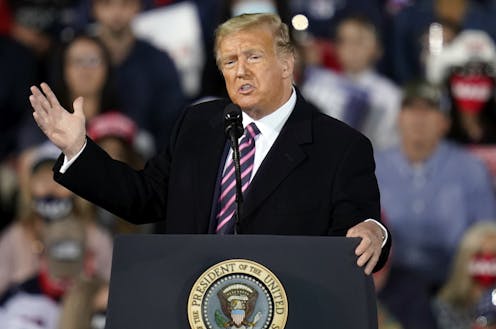Which of Trump's Supreme Court choices might be most reliably conservative?
- Written by Matthew Dahl, Ph.D. Candidate in Political Science, University of Notre Dame

As President Donald Trump looks to fill the Supreme Court seat[1] left open by the death of Associate Justice Ruth Bader Ginsburg, he and other Republicans want to secure a reliable conservative majority[2] on the nation’s highest court for many years to come.
They have tried to do this in the past, but it hasn’t worked out, because Republicans have repeatedly nominated justices who have drifted to the left[3] after they were confirmed.
My analysis[4] of the judicial records of 26 people currently serving as judges on Trump’s list of proposed nominees[5] suggests that this time will be different.
What predicts ideological drift
Psychologists have devised a way to quantify a person’s flexibility and tendency to change[6], and previous political science research has shown that this type of measurement can accurately predict a justice’s future ideological shift[7] on the Supreme Court.
In short, this predictive relationship exists because some people are more rigid in their thinking and find it hard to adjust their worldviews, whereas other people have more flexible outlooks and are more open to revision.
To measure this among the potential nominees, I collected every concurring and dissenting opinion written by the 26 people on Trump’s list who are currently serving as an appeals court judge or a state supreme court justice. Then I used a research-based piece of software[8] to evaluate the language the judges used in these 1,723 opinions – over 3 million words.
Finally, following the methodology of political scientists Ryan J. Owens and Justin Wedeking[9], I translated those opinions’ use of language into a score of each nominee’s psychological flexibility, which political psychologists call their “cognitive consistency[10].”
Trump’s choices’ cognitive consistencies
For comparison, I plotted these scores alongside the known prenomination scores for Associate Justice Clarence Thomas and retired Associate Justice David Souter. Thomas is widely regarded as being the most ideologically rigid[11] person on the current court. Souter, by contrast, was originally hailed as a “home run for conservatives[12]” when he was appointed by President George H.W. Bush, but he later drifted left and became a dependable liberal vote instead.
Trump’s prospective nominees are all more likely to drift than Thomas, but less likely than Souter, suggesting that they will all be reliably conservative.
The person least likely to drift is Barbara Lagoa[13]. The 52-year-old Cuban American now serves on the 11th U.S. Circuit Court of Appeals, and is reportedly one of Trump’s front-runners[14]. Based on this analysis, her decisions so far indicate that she has a relatively rigid thought process that would not yield to opposing arguments.
William H. Pryor Jr.[15] is the 58-year-old chief judge of the 11th Circuit. His prior decisions indicate he would be the potential nominee most open to change in the future, no matter his conservative bona fides now.
Why drift may not matter
Regardless of whom Trump picks, Republicans can afford some drift by their nominee.
To show why, I plotted the maximum potential drift over the next 10 years for each potential nominee whose current ideological position can be estimated[16] based on who appointed them to the U.S. Courts of Appeals.
Even assuming that Trump’s nominee drifts only leftward and never rightward, all but one of Trump’s possible picks is likely to remain more conservative than the moderate Chief Justice John Roberts, ensuring the Republicans maintain at least a 5-4 majority no matter what.
This could guarantee additional support for conservative outcomes, even if certain conservative judges sometimes decide to flip sides – like Associate Justice Neil Gorsuch, who infuriated Republicans[17] with a June vote to uphold employment protections for gay and transgender workers[18]. A new appointee from Trump’s list will likely shift the court’s balance so much further to the right that one justice flipping will have much less of an effect on any case’s outcome.
References
- ^ fill the Supreme Court seat (theconversation.com)
- ^ secure a reliable conservative majority (thehill.com)
- ^ drifted to the left (www.washingtonpost.com)
- ^ My analysis (github.com)
- ^ list of proposed nominees (www.npr.org)
- ^ quantify a person’s flexibility and tendency to change (doi.org)
- ^ predict a justice’s future ideological shift (doi.org)
- ^ research-based piece of software (doi.org)
- ^ Ryan J. Owens and Justin Wedeking (doi.org)
- ^ cognitive consistency (doi.org)
- ^ most ideologically rigid (www.newyorker.com)
- ^ home run for conservatives (www.washingtonexaminer.com)
- ^ Barbara Lagoa (www.nbcmiami.com)
- ^ reportedly one of Trump’s front-runners (www.washingtonpost.com)
- ^ William H. Pryor Jr. (slate.com)
- ^ current ideological position can be estimated (epstein.wustl.edu)
- ^ infuriated Republicans (theconversation.com)
- ^ employment protections for gay and transgender workers (www.washingtonpost.com)
Authors: Matthew Dahl, Ph.D. Candidate in Political Science, University of Notre Dame

